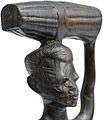Makonde art
Makonde art is the art of the Makonde people.
Makonde art can be subdivided into different areas. The Makonde traditionally carve household objects, figures and masks. After the 1930s, the Portuguese colonizers and other missionaries arrived at the Makonde plateau. They immediately showed great interest and fascination for the Makonde wood carvings and began to order different pieces, from religious to political “eminences.” The Makonde sculptors, after noticing such interest, decided to carve the new pieces using pau-preto (ebony wood, Diospyros ebenum) and pau-rosa (Swartzia spp.) instead of the soft and non long-lasting wood they had used before. This first contact with the Western culture can be considered to be the first introduction of the classical European style into the traditional Makonde style.Since the 1950s years the socalled Modern Makonde Art has been developed. An essential step was the turning to abstract figures, mostly spirits, Shetani, that play a special role. This shetani style originated in the early 1950s by master carver Samaki Likankoa, whose patron Mohamed Peera, an art curator in Tanzania played an instrumental and decisive role in influencing the modern makonde art movement. Some Makonde sculptors, the best known of whom is George Lugwani, have embraced fully abstract style of carving without discernible figures. Makonde are also part of the important contemporary artists of Africa today. The most internationally acknowledged such artist was George Lilanga.
The ex libris of ritual Makonde art are the unique Mapiko masks (singular: Lipiko), which have been used in coming-of-age rituals since before contact was made with missionaries, in the 19th century. These masks are painstakingly carved from a single block of light wood (usually 'sumaumeira brava') and may represent spirits ('shetani'), ancestors, or living characters (real or idealized). The dancer wears them so that he sees through the mask's mouth and the mask faces straight when he bends forward. Examples of such masks are provided in the second row of pictures below.




 An abstract carving by George Lugwani in mpingo.
An abstract carving by George Lugwani in mpingo.
See also
Literature
- Zachary Kingdon: A Host of Devils: The History and Context of the Making of Makonde Spirit Sculpture (2002)
- Jorn Korn, Jesper Kirknaes: Modern Makonde Art (1974)
- Mohl, M.: Masterpieces of the Makonde (1990)
- Stout, J.A.: Modern Makonde Sculpture (1966)
External links
- More information about Makonde Art see:
- PhD Thesis concerning Makonde carvers:
| Wikimedia Commons has media related to Makonde art. |